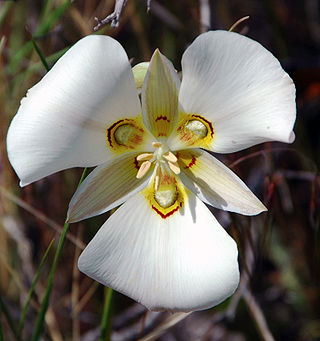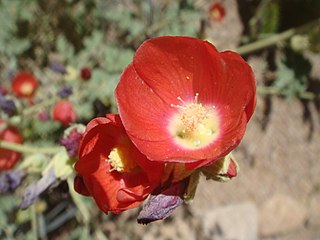
Calochortus nuttallii, also known as the sego lily, is a bulbous perennial plant that is endemic to the Western United States. The common name of sego comes from a similar Shoshone word. It is the state flower of Utah.

Isocoma, commonly called jimmyweed or goldenweed, is a genus of North American semi-woody shrubs in the family Asteraceae. It is found in the semi-arid areas of Southwestern United States and Mexico.

Isocoma tenuisecta, commonly called burroweed, shrine jimmyweed, or burrow goldenweed is a North American species of small, flowering perennial herbs in the family Asteraceae. It is native to Arizona, New Mexico, and Sonora.

Isocoma pluriflora, commonly called southern jimmyweed or southern goldenbush, is a North American species of flowering perennial herbs in the family Asteraceae. It grows in northern Mexico and in the southwestern and south-central United States.

Isocoma acradenia is a North American species of flowering plant in the family Asteraceae known by the common name alkali goldenbush.

Sphaeralcea rusbyi is a species of flowering plant in the mallow family known by the common names Rusby's globemallow and Rusby's desert-mallow. It is native to the southwestern United States, where it can be found in various types of desert habitat. The species is generally divided into three subtaxa which grow in separate sections of the desert southwest. In general, the plant produces hairy or woolly stems which can reach three meters tall. The leaves are lobed or compound. The flowers each have five red-orange petals up to 2 centimeters long.
Tetraneuris scaposa is a North American species of flowering plant in the sunflower family. It is native to the southwestern and south-central United States and northern Mexico.
Isocoma azteca, common names Apache jimmyweed or Aztec goldenbush, is a plant species native to Arizona and New Mexico. It grows on sandy to clay soils, often with Atriplex sp., at elevations of 1,500–1,800 m (4,900–5,900 ft).
Primula rusbyi is a species of Primula. A common name is Rusby's primrose.
Brickellia rusbyi, the stinking brickellbush, is a North American species of flowering plants in the family Asteraceae. It is native to northern Mexico and the southwestern United States.
Gaillardia multiceps, the onion blanketflower, is a North American species of flowering plant in the sunflower family. It is native to the southwestern United States.
Gaillardia parryi, or Parry's blanketflower, is a North American species of flowering plant in the sunflower family. It is native to the southwestern United States. Some of the populations are inside Grand Canyon National Park, others in Grand Staircase–Escalante National Monument.

Heterotheca subaxillaris, known by the common name camphorweed, is a North American species of flowering plant in the family Asteraceae. It is widespread across much of the United States as well as Mexico and Belize.
Hymenoxys rusbyi is a North American species of flowering plant in the daisy family known by the common names Rusby's rubberweed or Rusby's bitterweed. It has been found only in the states of Arizona and New Mexico in the southwestern United States.
Tetraneuris linearifolia is a North American species of plants in the sunflower family, known by the common name fineleaf fournerved daisy. It grows in the south-central United States and northern Mexico.
Tetraneuris argentea, the perkysue, is a North American species of plants in the sunflower family. It grows in the southwestern United States, primarily in Arizona and New Mexico with additional populations in Utah, Colorado, and the Texas Panhandle.

Tetraneuris ivesiana is a North American species of flowering plant in the sunflower family, known by the common name Ives' fournerved daisy. It grows in the southwestern United States, in Arizona, New Mexico, Utah, and Colorado.
Isocoma humilis, common names Zion goldenbush or Zion jimmyweed, is a rare North American plant species in the family Asteraceae. It has been found only in southern Utah in the United States. Some of the populations lie inside Zion National Park.
Isocoma drummondii, the Drummond's goldenbush, is a North American plant species in the family Asteraceae. It has been found on both sides of the Río Grande, in Tamaulipas and in southern Texas.
Isocoma coronopifolia, the common goldenbush, is a North American plant species in the family Asteraceae. It has been found on both sides of the Río Grande, in Tamaulipas, Coahuila, Nuevo León, Chihuahua, and southern Texas.







